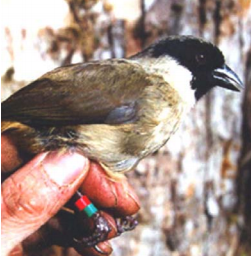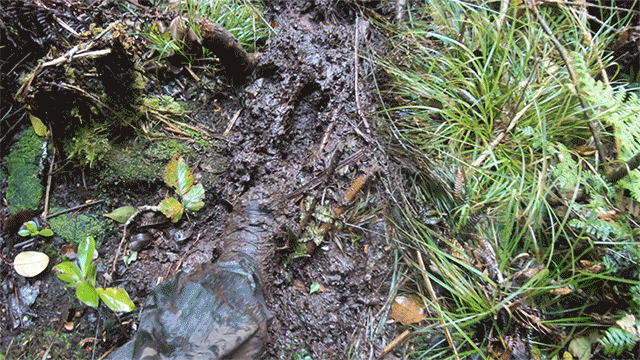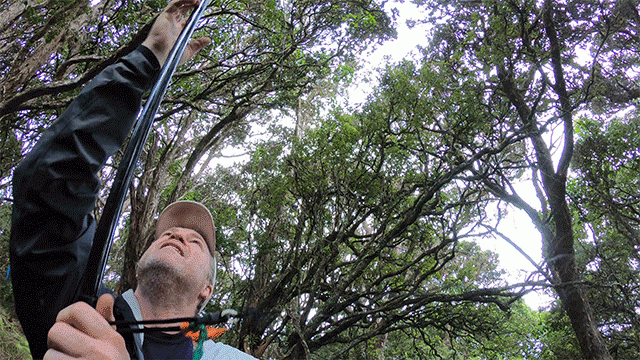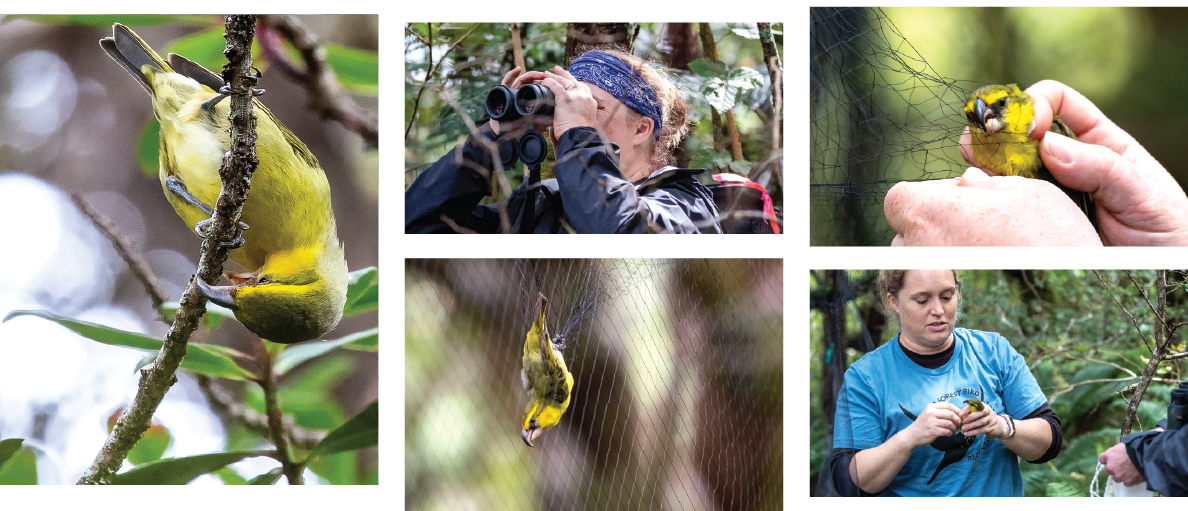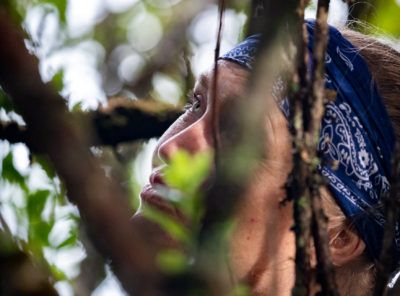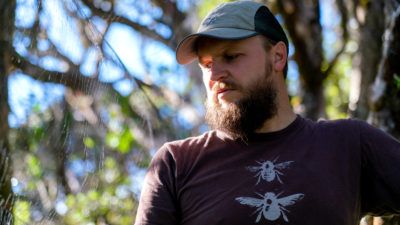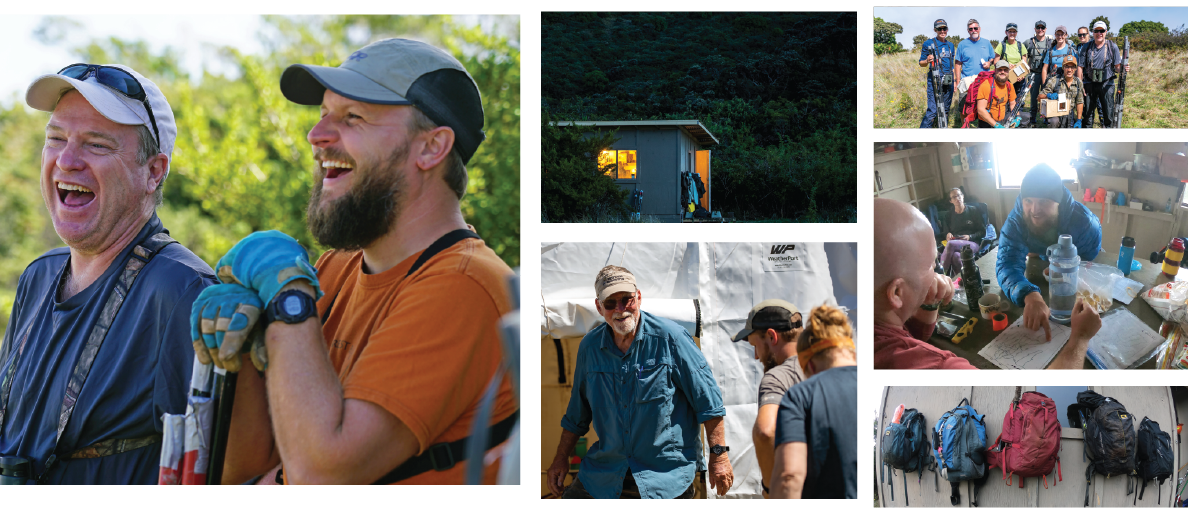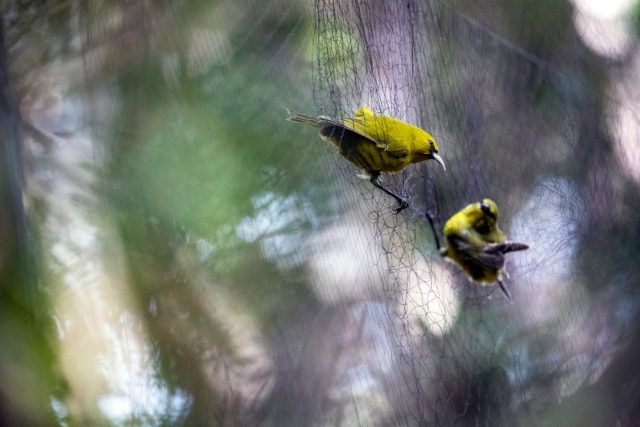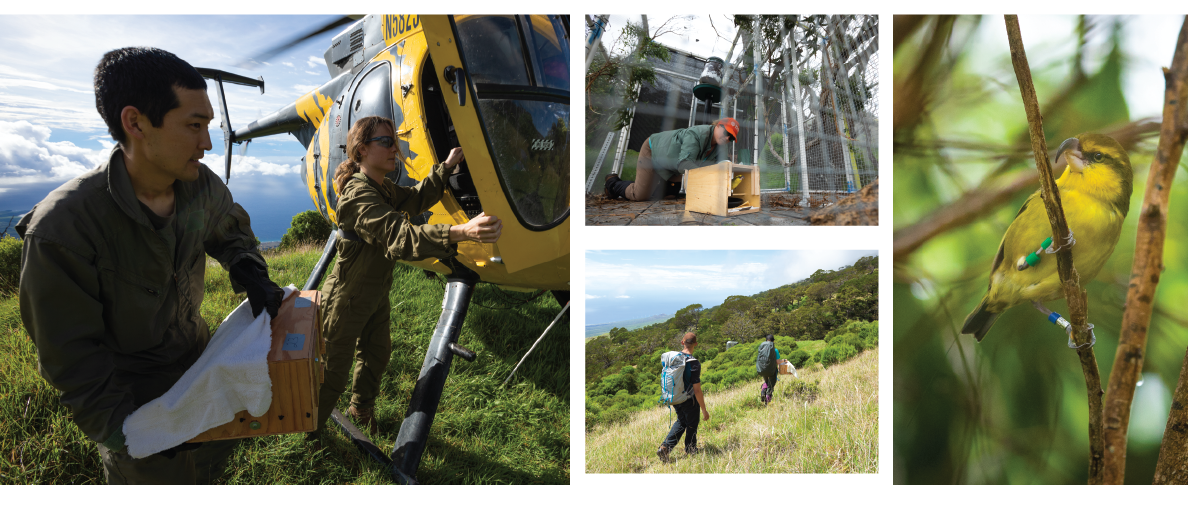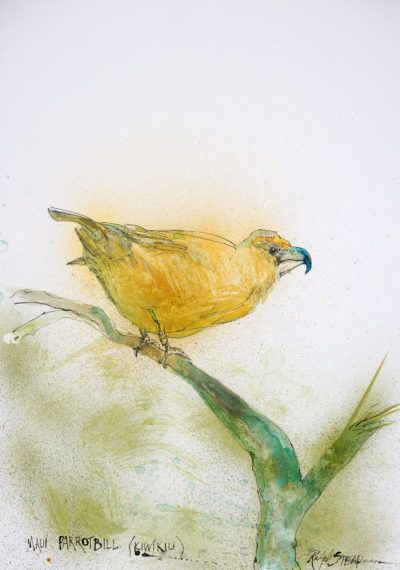View the full interactive experience on the Honolulu Civil Beat website.
HANAWI, Maui — Sitting in the mud on a forest bed of ferns, Hanna Mounce searches for a new track on her old MP3 player.
She squints through spitting rain at the mystical ohia trees, adorned with lovers-red lehua blossoms. They dominate the landscape up here on the north slope of Haleakala, the 10,000-foot shield volcano in East Maui.
Mounce taps a button and a bluetooth speaker nestled in rotting, moss-covered branches begins to chirp 10 yards away. She skips to the next track, sporadic cheeps.
It’s a recording of a Maui parrotbill, or kiwikiu in Hawaiian, now among the world’s most endangered birds. She hopes to lure one into a nearly invisible 30-foot net strung up between two fishing poles that are staked into the ground with PVC pipes.
The birds are in peril. Once widespread on Maui and Molokai, the population of kiwikiu (pronounced kee-vee-KYOO’) has plummeted after years of disease and destruction of forests.
Mounce and her team have taken it upon themselves to prevent their extinction. That effort began more than a decade ago with the rebuilding of native forests in Nakula Natural Area Reserve on the other side of the mountain.
It’s all led up to this nine-day trip to capture a dozen kiwikiu here in Hanawi Natural Area Reserve and move them to Nakula where they hopefully will start a second population — an insurance move that’s worked to save other rare species. Scientists estimate only 44 to 312 birds are left.
Mounce tries another track she hopes will attract the kiwikiu, playing the little olive-green bird’s descending song. Its string of short cheering whistles joins the chorus of other forest birds flitting about the tree canopy. The scarlet iiwi lets loose like a loud rusty hinge. The punk rocker akohekohe ruffles its feathered mohawk. The alauahio lands in a branch like an errant tennis ball.
This upper portion of the mountain, which at 6,800 feet looks out over rolling cumulus clouds, provides refuge for the final few kiwikiu as well as several other species of Hawaii forest birds.
Climate change has only increased the threats that the birds face, making the need to take action more dire than ever as storms worsen, rainfall patterns change and a warming planet ushers mosquitos with avian malaria to higher ground.
This wouldn’t be the first endemic forest bird to make its final stand in these woods. The poouli, a black-faced honeycreeper, went extinct in 2004 despite attempts to save it.
Mounce, 39, is familiar with the story. A member of her team on this trip was there when it happened. No one wants to witness the loss of another species in Hawaii, already deemed the “extinction capital of the world.”
But if there was a lesson with the poouli, it was doing too little, too late. There were only three birds left when biologists set out to bring them in to breed in captivity as a last-ditch effort to recover them.
Scientists are more optimistic about the kiwikiu. But they know that if nothing is done, it will likely die out within 25 years. To be seen only as another stuffed bird at the Bishop Museum, a reminder of what once was.
The cool mist turns to a cold rain. Mounce tightens her navy bandana around her head and tugs at the hood of her black Patagonia jacket.
She recalls starting in 2006 as an intern with the Maui Forest Bird Recovery Project, based in Makawao. Now she leads the nonprofit, bringing together the 11-member team on this trip into Hanawi.
In addition to her small staff, the team includes biologists from the Hawaii Division of Forestry and Wildlife, the U.S. Fish and Wildlife Service and the American Bird Conservancy. It includes veterinarians from San Diego Zoo and a volunteer “bird nerd” from the Big Island. And it includes the head of Pacific Bird Conservation, one of the foremost experts in trapping wild birds, moving them and caring for them in captivity.
The team arrives by helicopter just after dawn at the base camp known as Frisbee Meadow, near the upper edge of Hanawi. The chopper also carries three sling loads with almost 1,500 pounds of gear. They unpack in the morning drizzle before fanning out into the depths of the forest.
The 7,500-acre watershed, managed by DOFAW after the reserve was established in 1986, is home to the state’s biggest concentration of endangered Hawaiian birds. Hanawi is the kiwikiu’s last stronghold.
Basically, this limited rainforest is out of room for more parrotbills. That’s created an aging population with a bleak outlook. Their offspring are forced to seek homes farther downslope, but that means dipping below the so-called mosquito line at about 5,700 feet where they aren’t safe from disease. One bite can be fatal.
In whispers, Mounce recaps her plan to ensure the Maui parrotbill’s survival.
On the surface, it’s simple. Catch a dozen kiwikiu in Hanawi and release them in Nakula on the other side of the mountain.
Pigs, goats, rats and deer had devastated Nakula. But after more than a decade of restoration and surveys to ensure it was free of predators and mosquitos, the reserve finally seems ready to once again host the kiwikiu and other native forest birds.
Nakula has been replanted with more than 250,000 native trees and shrubs. There’s now a fenced-in forest, about 420 acres of the 1,500-acre reserve. Mostly koa and ohia trees at just under 6,000-feet elevation.
Zach Pezzillo, a volunteer-turned-employee with the recovery project, will be waiting there in Nakula with several others to receive the birds, attach tiny radio transmitters and release them into the wild.
“It’s incredibly exciting,” he said while loading gear into helicopter slings the day before the departure. “Two weeks from now, kiwikiu will be on the Nakula side for the first time in decades, maybe a century.”
Biologists say the Maui parrotbill, like other forest birds, used to live at lower elevations where the conditions are less harsh than places like Hanawi with its howling winds and torrential rain. But between the weather and the mosquitos, they’ve been pushed up to higher elevations.
“You realize very quickly that this is not where they want to be but the only choice of the habitat they have left,” says Mounce, who has a doctorate in biodiversity conservation from the University of Kent.
Another half-hour passes without a word. Mounce idly removes dirt from her nails and sits back against the peeling bark of an ohia. The rain stopped and with it the wind.
She scans the forest with her binoculars. So does Chris Farmer, Hawaii director of the American Bird Conservancy, who found a spot behind an unfurling fern where he could still see the net.
Deena Brenner, senior veterinarian with the San Diego Zoo, sits silently a few feet away. The zoo is breeding kiwikiu at the Maui Bird Conservation Center in Makawao, near the offices of the Maui Forest Bird Recovery Project.
This is her first time in the reserve. She describes the forest as feeling “prehistoric.” And in many ways it is, given that nearly every single plant and animal species in it is native to Hawaii, evolving here over thousands of years.
The trio doesn’t have to wait long. Just after noon, a vibrant yellow male kiwikiu darts into the net he never saw.
The bird, maybe 5 inches long and just under an ounce, remains calm as Mounce carefully untangles it and Farmer and Brenner slide over to help.
An hour into their first day in the field and they have their first bird. Hanna radios the good news to her colleagues, Chris Warren and Laura Berthold, who are spread out farther downslope waiting with their own nets.
“It’s beautiful,” she says, wiping away a tear.
It’s not a competition, but it kind of is. With only nine days to capture upwards of 12 birds, every moment counts. As the week wears on, there’s playful banter about how many birds they’ve each caught — or haven’t caught.
Mounce is satisfied to have caught that first kiwikiu. It would turn out to be a high point of the trip.
Together they put the bird into a specially made wooden box. After taking measurements and photos, Mounce dispatches Brenner and Farmer to carefully hike it up the mountain where the makeshift “bird room” is waiting.
Back at base camp, Peter Luscomb is ready to receive the parrotbill when it arrives.
A WeatherPort tent is filled with rows of empty boxes, each one waiting to hold a kiwikiu. It smells musty and a bit musky and is quiet except for the flapping of the fabric against the frame.
Luscomb has stations set up for food, mostly mealworms. The kiwikiu’s preferred diet is insect larvae. They use their unique parrot-like bills to split open berries or peel back bark to find their food like a woodpecker would on the mainland.
“I can’t imagine how these birds survive up here,” he says. “They’re tough-ass birds — with the wind, the rain, the cold.”
With his zoo days behind him, he now leads the Kailua-based Pacific Bird Conservation, a nonprofit he cofounded in 2012.
Luscomb is no stranger to the team. He worked with John Vetter, a biologist with Fish and Wildlife Service, on a project in 2011 and 2012 to prevent the Nihoa millerbird from going extinct. The small gray bird is endemic to Nihoa, a tiny island about 300 miles from Honolulu in the Northwestern Hawaiian Islands.
They caught 50 millerbirds on Nihoa and took them to Laysan, a small island farther up the archipelago. Within two years, the new population had tripled.
It’s the kind of success story they want to tell one day about the kiwikiu.
With each trip, including this one, Luscomb is still eagerly learning. How can the design of his bird-carrying boxes be refined? What’s the best way to keep the birds content in captivity? Maybe fewer holes on the side? Or a curved ceiling to reduce injuries when excited birds bonk their heads?
Over the next several days, his boxes fill up with a dozen birds. He checks on them regularly, weighing them in the morning and evening with help from Brenner and others. They collect blood samples, monitor their health and check their activity level, always watching for signs of distress.
The birds are looking good. The problem is they’re all males.
The team gathers around the picnic table in the main building as Vetter stirs a sweet potato stew for dinner.
They are down to their final days in the field and have 13 male birds.
“We need a change of plans, because what we are doing is clearly not working,” Farmer says.
No one had experienced anything like it. Not in all the years of studying kiwikiu or other forest birds for that matter. They had always caught about a 50-50 sex ratio.
Was it too close to the breeding season? Too far? Something else?
Everyone weighs in with a suggestion. Just release a few of the males. Take them all and come back in November or January to try to catch more females. Take half and release the rest. Scrap the whole thing.
Each option comes with its own set of logistical challenges and scientific uncertainty.
“This is uncharted territory,” Mounce says.
There’s a lot riding on whichever course she ultimately decides. It takes an incredible effort to cobble together the money and partners to make each trip happen, and this one was no exception.
There’s also significant personal sacrifice in so much of what each individual does. No one is in this line of work to be comfortable, financially or physically. They’re driven by the mission, a calling to do their part to prevent another extinction.
“We’ve brought them to this perilous point,” Luscomb says. “It’s up to us to recover them.”
There’s a constant competition for grants, hustling for funding and publishing papers to further our understanding of the natural world. All while barely making ends meet. Even with advanced degrees, some live in affordable housing, others depend on roommates. No one complains.
Mounce, a married mother of two, found out right before this trip that she needs knee replacement surgery. She wonders if it was from playing volleyball in college or too many helicopter operations for the birds. The cartilage is just gone.
In her week home between this trip in Hanawi and the next one in Nakula, she’s throwing a birthday party for her 3-year-old daughter. Her actual birthday is during this trip.
The team agrees that trying to establish a second population in Nakula with a bunch of alpha males and just a couple females brought over from the captive breeding facility would not end well for the birds.
The following morning, Mounce decides to mix it up.
She abandons the playback strategy with the speakers in favor of a passive approach that involves setting up more nets in each area and essentially hoping for the best. “Shotgunning it.”
Farmer is pulling out his eighth amakihi — another Hawaii forest bird but not the parrotbill they’re seeking — from one of two nets he’s running when Mounce checks in on the radio just after 3 p.m.
“Crickets, crickets, crickets,” he tells her. Not even so much as a sighting of a kiwikiu all day.
“It would really help my options here in my notebook if you could catch a female kiwikiu,” she tells him.
“Copy that.”
Finally, they catch a break. The radio crackles with news that a group farther downslope has caught a female. Then another one. Now, with one day to go, they at least have options.
The final decision is a compromise. Five males and two females make the journey over Haleakala to the south slope in Nakula. They release the rest back into Hanawi.
In Nakula, the seven birds from Hanawi join seven birds from the Maui Bird Conservation Center that have been waiting there the past week in aviaries in the forest.
The vets decide one of the kiwikiu from the breeding facility isn’t fit to be released into the wild so it’s returned to the conservation center.
Thirteen parrotbills are outfitted with radio transmitters and released in Nakula. But less than a month later, only three have survived — two males and one female. A fourth may still be out there but it lost its tracking device and hasn’t been found.
High mortality rates are expected in bird translocations, Mounce says, but they are shocked. Devastated, really.
Early tests show avian malaria is the culprit. A horribly ironic twist of fate.
The team had surveyed the area for signs of mosquitos carrying the disease. The site was supposed to be high enough to be safe.
Mounce wonders if this summer’s record heat played a role. It may have brought the mosquitos to higher elevations far sooner than anyone expected.
“We just needed a malaria answer yesterday,” Mounce says. “We need this disease issue tackled at a higher level.”
It’s taken an emotional toll on her and the rest of the team. Walking back up from the field site in Nakula, Warren tells Mounce that he’s just all cried out.
She’s struggling to keep a positive attitude. They know that taking bold actions might not work. They also know that not taking action will end in extinction.
“We still come back to if we do nothing, we hands down know what will happen,” Mounce says.
Plans are on hold for now for moving any more kiwikiu. But she highlights that they still have a restored native forest and protected watershed, which is good for everyone.
Restoring the forests by fencing out hoofed animals and planting native trees helps other endangered forest birds. Only six species still exist on Maui, down from about 60 before Polynesians and Europeans arrived.
The work also improves and protects the watershed, critical for freshwater drinking supplies downslope and sequestering planet-warming gases from the atmosphere to slow the effects of climate change.
“We put a value on protecting biodiversity,” Mounce says. “Not everybody has that value and you can’t always convince people to have that value. So if you don’t care about birds and you don’t care about biodiversity and I can’t convince you of that, that’s fine, but you still use water.”
The learning continues, she says. And no one is giving up.
Project Team
Reporting, Photography and Videography: Nathan Eagle
Multimedia: April Estrellon, Carlie Procell, Ku’u Kauanoe, Claire Caulfield
Editing: Jessica Terrell, Patti Epler
Site Development: Mantle

